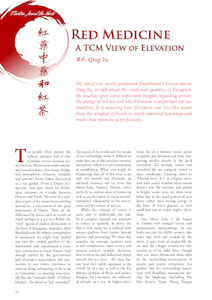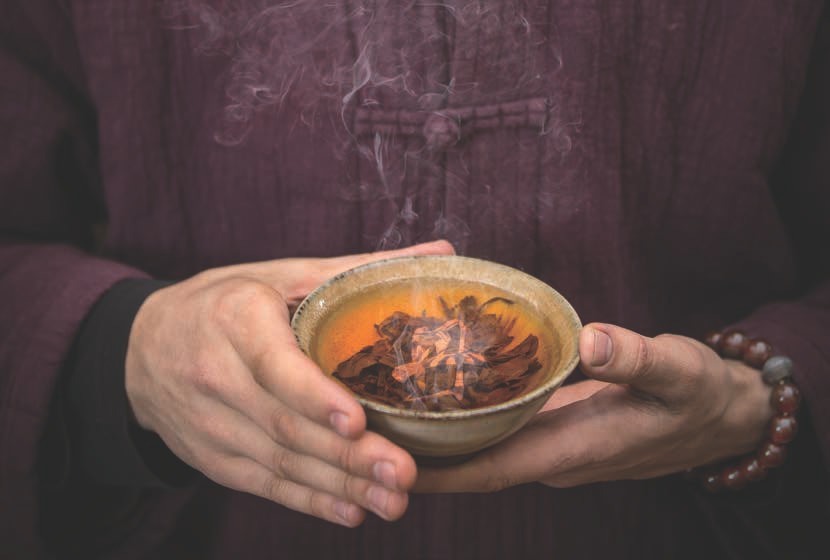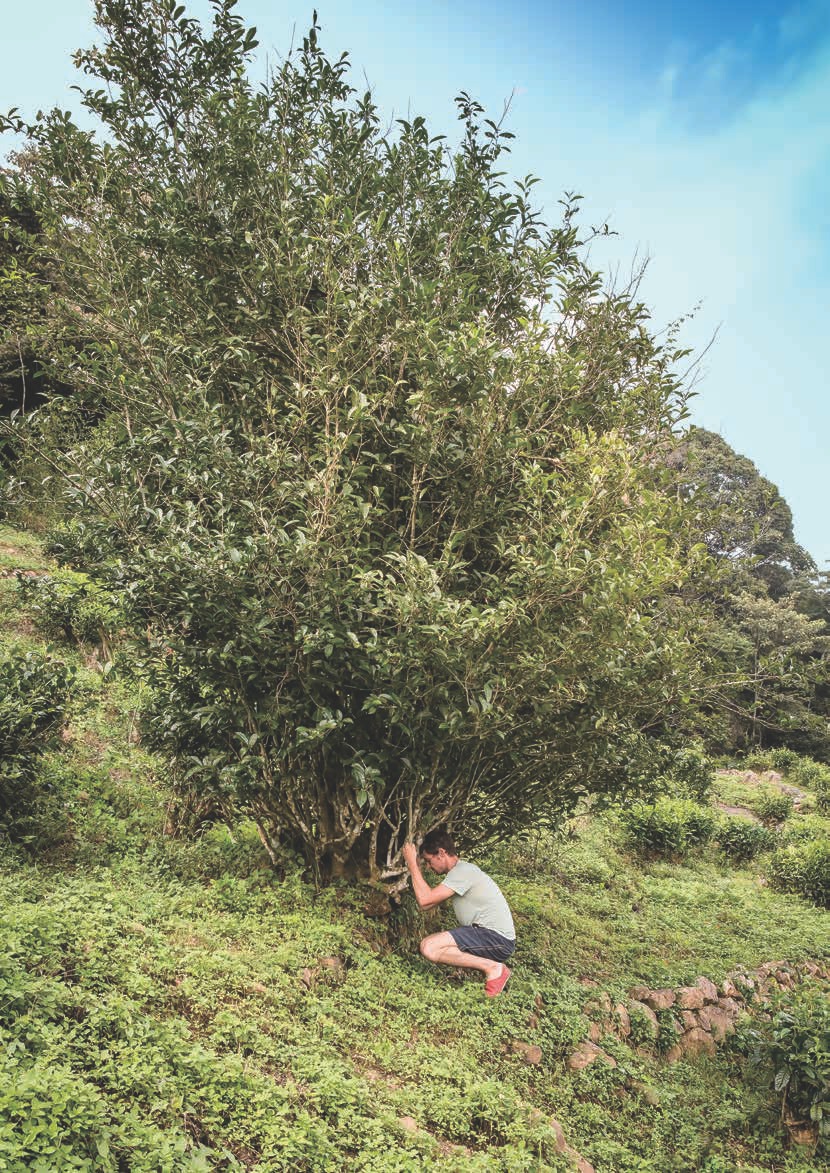
 |
|
Tea people often ponder the infinite, intimate web of relationships woven between terroir and tea. The immeasurable cadence and complex dance of so many biological, atmospheric, climactic, energetic and seasonal forces imbue distinction to a tea garden. From a Daoist perspective, man goes about his diminutive existence in a realm between Heaven and Earth. We serve as a conduit or gyre of the many forces swirling around us, a microcosm of the great macrocosm of Nature. Thus, we are influenced by forces such as terroir, as much perhaps as a tea tree. Before the "viral" spread of endless distractions in the form of Instagram, Snapchat, daily Buzzfeeds and the infinite complexities of modernity, we might have looked out into the vaulted pavilion of the macrocosm and experienced a more tacit connection to Great Nature. And though cajoled by the gravitational pull of modern materialism, this connection to our source continues to move us along, whispering in the wind to "remember," or tweeting non-virtually like the "reminder birds" of Aldous Huxley's The Island to "pay attention!" The speed of the world and the nature of our technology make it difficult to make best use of this precious resource (attention), which is a core component of mindfulness. What, you might be wondering, does all of this have to do with this month's tea? Elevation, an old-bush Assamica red tea from Sun Moon Lake, Nantou, Taiwan, serves perfectly to explore ideas of terroir (as well as social context or social terroir), humanity's relationship to the macrocosm and the virtues of red tea.
While the concept of terroir is quite easy to understand, the reality is complex, beyond any attempts to reduce or quantify. In short, the idea is that many tea is imbued with unique qualities from factors beyond genetics and processing. We must also consider, for example, qualities such as soil composition, water source and mineral content, weather, elevation, local ecosystems and influential plants around the tea trees. All these factors lend their subtle signature to the overall Qi of a tea, as well as the less abstract qualities of flavor and aroma. Imagine, for a moment, the influence of altitude on a tea. At higher elevations, the air is thinner, cooler, prone to greater precipitation and mist, supporting smaller shrubs in the local ecosystem. The animals, insects and microbial life are uniquely suited to these conditions. Growing closer to "Heaven (tian, 天)" at a higher elevation with cooler weather often means sweeter teas. By contrast, teas grown in bright, sunny areas are often more bitter due to the rapid growth of new leaves rather than storing energy in the form of sweet glucose, as with small-bud teas at cooler, higher elevations.
Sun Moon Lake is the largest in Taiwan with tranquil waters and mountainous surroundings. As one looks out over the idyllic scenery, lake water laps with low sounds by the shore. A quiet hum of cicadas fills the air, and the villages around the lake remind us of an older time, though they are more threatened these days by the encroaching development of resorts and tourist attractions. Tea gardens line the surrounding mountains with Buddhist monasteries dotting the landscape (including Wu De's favorite Xuan Zhang Temple where we always stop to meditate). At a moderate elevation of 748m (2,454ft.) above sea level, the red teas of this region maintain the sweetness found at higher altitudes with the bitterness of sunny, fully oxidized, tannin-rich teas. Elevation, like most red tea, consists of one bud and two leaves, processed into a dark-colored leaf, yielding a deep crimson liquor. Elevation is withered, rolled, oxidized and dried. Through oxidation, the tannins develop and the tea becomes richer, more robust and invigorating, with flavors of malty dried fruit, spices, bittersweet cinnamon and cacao. The aroma is very comforting, as is the tea, despite its full flavor and enlivening Qi. Terroir, along with the genetic composition of the cultivar and the processing methodology, all combine to create Elevation. And while they may appear separate, the processing requires the masterful vision and understanding of the tea farmer. In order to understand this complex process, it is helpful to review some basic Daoist ideas that underlie all Daoist arts including Cha Dao.

When observing Nature, as well as our place within the macrocosm, ancient Daoist sages astutely attributed certain qualities to the movements and mechanics of life. They observed the salient, constantly shifting interplay between yin and yang, sun and moon, Heaven and Earth, day and night, birth and death, solstice and equinox, etc. The vicissitudes of yin and yang take more distinct form as the five elements: wood, fire, earth, metal and water. And the interactions between the five elements produce the six atmospheres of cold, heat, wind, moisture, dryness and fire. Every aspect of the biosphere, every movement of life, takes place within the magnificent tapestry woven by the interactions of the elements and atmosphere. The health of a species and its habitat depends upon the harmonious relationship between these elements. Human health depends upon our ability to live in harmony with Nature, understanding that we cannot separate a person or group of people from the context of their lives. Further, Nature "cooperates" to help humans live a balanced life. Take, for example, the growth of seasonal vegetables and their influence on health. The spring is the time of the wood element, during which an upward and outward movement, like a growing tea tree, spurs the sudden proliferation of life. This time of blooming birth and verdant vernal life is characterized by sudden movement, longer days, growing heat, leafless trees bursting into life, overflowing seas and rivers, tornadoes and hurricanes, thunder and lightning. According to Daoist medicine, spring belongs to the wood element and dominates functions of the liver. If we don't adapt to the changing climate in spring, we may be susceptible to seasonal health problems, such as flu, pneumonia, or a relapse of chronic diseases. It is advisable to reduce the intake of sour flavors and increase sweet and pungent flavors as this enables the liver to regulate the vital energy throughout the body. As I mentioned, Nature "cooperates," helping produce foods that support our health during the appropriate season. This is not to anthropomorphize Nature, but to say that our existence grew out of our environment.
Examples of recommended foods for the spring include onions, leeks, leaf mustard, yam, wheat, dates, cilantro, mushrooms, spinach and bamboo shoots. Fresh green and leafy vegetables should also be included in meals; sprouts from seeds are also valuable. As cold winter keeps us indoors and tends to make us eat too much, people may develop a heat imbalance in the spring, which leads to dry throats, bad breath, constipation, thick tongue coating and dry skin. Foods like bananas, pears, water chestnuts, sugar cane, celery and cucumber help to clear the excessive heat.
This exploration of humanity's relationship to Nature, the elements, the atmosphere, the seasons and seasonal foods illustrates the connection we have to Nature. The most obvious way that we interact with Nature is through the food that we grow, harvest, share and consume. All plants have their own reality - their own duties and powers. Each is not only unique, but is given the gift of life and must be respected if its full potential is to be realized.
Now, let's return to the inherent power of Sun Moon Lake red tea. Just as we discussed the Daoist qualities of seasonal foods, so too can we discuss the qualities of Elevation red tea. Elevation is a "spring and summer" tea in the sense that it contains the wood element's upward and outwardly moving Qi. The leaves are abundant, full, large and pulsating with spring yang energy, providing warmth and moving to the surface of the body. This movement increases blood circulation, which is a drying, heating process. However, the slight bitterness of the leaf is associated with summer fire energy, and the bitter flavor clears heat from the body. Thus, the bitterness balances the heating and drying functions of the strong Qi. All this talk of flavors, elements, temperature and Qi is important in understanding one simple thing: different teas, like different foods, are ideal for specific seasons. We can thus enjoy teas that are appropriate to the season so as to maintain balance and harmony in our lives. Further, we can pick more appropriate teas for a given tea ceremony based on the intention of the tea ceremony.
Elevation is satisfying and approachable for everyone, like a person with an affable, kind, big-hearted personality; a personality like the first day of spring. The large, healthy leaves are ideal for a bowl, especially during the morning when we are seeking simplicity and an uplifting Cha Qi to start the day. Also, you might notice when you drink this tea with others that the mood lightens and people become more talkative. Part of the reason for this shift lies in the flavors of the tea. Sweet corresponds to the earth element and has a harmonizing effect, bringing a sense of comfort and home to the tea. On the contrary, the bitter flavor goes to the heart, allowing the spirit to be at ease, and stokes the fire element, which leads to a desire to socialize and share. For these reasons, Elevation has been an ideal tea for many people just starting out on their tea journeys. It only requires a simple bowl and boiling water, thus making it ideal for sharing with loved ones. In fact, red tea was the first tea to spread throughout Europe and the rest of the world due to the qualities previously discussed. It is the perfect tea for "social terroir" in the sense that the yang, bittersweet, talkative nature of the tea made it a likely candidate for geographic and social movement.
There exists an intertwining relationship between meditation, tea and enlightenment. Tea also cannot be described in words, but only tasted directly right here and right now. Elevation is ideal as a bowl tea, and in our tradition, bowl tea is about casting off qualitative considerations. We return to appreciation of meditation, simplicity, openness, receptivity and connection to those with whom we share the moment. For these reasons, Elevation holds a very important role in our tradition because it keeps two essential functions of tea intact: humility and connection. Those of us in the Los Angeles community who have been drinking tea for many years, and who appreciate the refinement of gongfu tea, often return to bowl tea with Elevation when sharing tea with a person new to Cha Dao, when sharing with a large group, or when we wish to return to our roots, which we must do, and regularly. This remembrance of and return to one's roots is as essential to sharing tea with an open heart as it is to remaining a student. The Way of Tea is a long, winding path into the misty mountains - a path that one could walk for many, many years before reaching the peak. In fact, one would reach the peak only to realize that he or she is surrounded by summits, each with its own tea path. Thus, the imperative to remain always a student in this life of tea is fundamental, and Elevation red tea can certainly accompany us like an old, wise friend who reminds us to stay humble and keep learning along the way.
